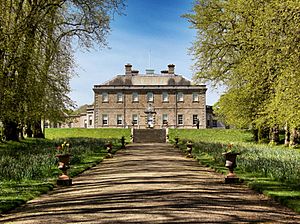William Gordon, 2nd Earl of Aberdeen facts for kids
William Gordon, the 2nd Earl of Aberdeen (born 1679, died 1745), was an important Scottish landowner and politician. For many years, from about 1691 to 1720, people knew him as Lord Haddo. He was a member of the Tory political group.
He briefly served in the British Parliament from 1708 to 1709. However, he was not allowed to stay because he was the eldest son of a Scottish noble (a "peer"). William Gordon had some support for the Jacobite cause, which wanted to bring the old royal family back to the throne. But he did not join in any of their rebellions.
Contents
Early Life and Family
William Gordon was born in 1679 and was baptized on December 22nd. He was the fourth son of George Gordon, the 1st Earl of Aberdeen. His mother was Anne Lockhart. Even though he was the fourth son, he became the oldest surviving son after his older brother passed away in 1691. This is when he received the special title of Lord Haddo.
Around 1705, Lord Haddo married Lady Mary Melville. She was the only daughter of the 5th Earl of Leven.
Political Career and Life Changes
In 1704, Lord Haddo became a member of the Scottish Privy Council. This was a group of advisors to the King in Scotland. After Scotland and England joined together in 1707 (the Acts of Union 1707), this council was ended.
In 1708, he was elected as a Member of Parliament for Aberdeenshire. But because he was the eldest son of a Scottish noble, he was not allowed to be an MP. He was replaced by Sir Alexander Cumming a year later.
Sadly, his first wife, Mary, died in 1710 while giving birth to their second child. After a change in the government in 1710, he got a new job. He became a Scottish Commissioner for trade, but it was an unpaid role. He lost this job in 1714 when a new royal family, the Hanoverians, came to power. During the 1715 Jacobite rebellion, he stayed in Edinburgh and did not take part.
Around 1716, Lord Haddo married his second wife, Lady Susan Murray. She was the daughter of the 1st Duke of Atholl. In 1718, he helped with a review of St Andrews University.
In 1720, he inherited his father's titles and became the 2nd Earl of Aberdeen. The next year, in 1721, he was chosen as a representative peer. This meant he could represent Scottish nobles in the House of Lords in Parliament. His second wife, Susan, also died while giving birth to their last child. Later, he married his third wife, Lady Anne Gordon. She was the daughter of the 2nd Duke of Gordon.
In 1732, he finished building Haddo House. This large house is located near Tarves in Aberdeenshire. A famous architect named William Adam designed it.
Later Life and Family Legacy
Lord Aberdeen passed away in Edinburgh on March 30, 1745. He had bought several large pieces of land, including Ballogie, Boddam, Crichie, Fedderat, Fyvie, Ruthven and Tarland. His oldest son, George, inherited his titles and lands. His family did not take part in the Jacobite rebellion that happened later that year.
William Gordon had many children from his three marriages:
Children with Lady Mary Melville
- Lady Anne Gordon (1709–1755): She married the 5th Earl of Dumfries.
- Lady Mary Gordon (born and died 1710).
Children with Lady Susan Murray
- George Gordon, 3rd Earl of Aberdeen (1722–1801): He became the 3rd Earl.
- John Gordon (died 1727).
- Lady Catherine Gordon (1718–1779): She married the 3rd Duke of Gordon.
- Lady Susan Gordon (died 1725).
Children with Lady Anne Gordon
- General William Gordon (died 1816): He was a military officer and also served in Parliament.
- Colonel Cosmo Gordon (died after 1783).
- Alexander Gordon, Lord Rockville (1739–1792).
- Captain Charles Gordon (died 1771).
- Lady Henrietta Gordon: She married Robert Gordon.
- Lady Elizabeth Gordon (born 1734).


